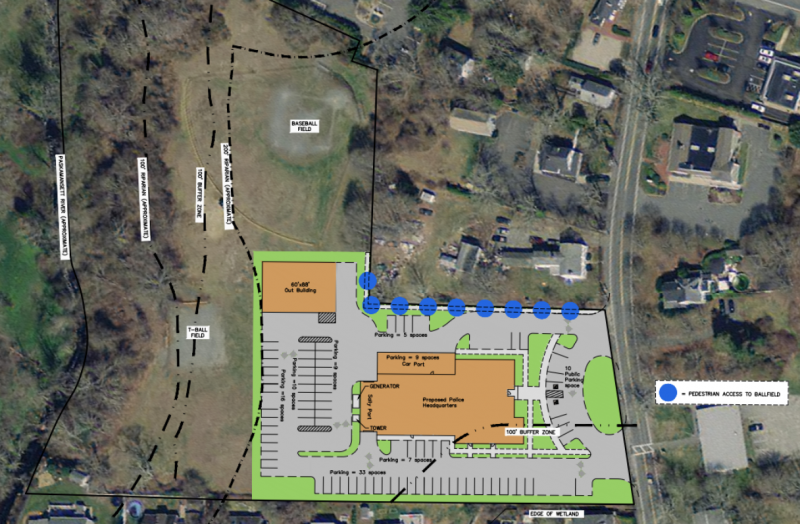Town airs concern over field replacement, station costs
Community members on Monday expressed concern about losing access to the ball fields at the Gidley School property, as well as the $13.4 million cost of the new police station that will replace the school itself.
“Now we’re looking at a police station that this town has never, ever had. It’s time for the town to step up and do the right thing,” Selectman Shawn McDonald said in support of the project at a joint meeting of the Select Board, the Finance Committee, and the advisory committee charged with overseeing the police station build.
Demolition of the Gidley School started on March 6, and officials expect the six- to eight-week process to finish before the Dartmouth Youth Activities Association needs the Little League fields at the end of May. However, officials expect that if their request to approve the 21,800-square-foot police station passes at June Town Meeting, construction could start the very next day, potentially cutting access to the fields again.
The project is scheduled to have a May 2019 grand opening.
Residents initially voiced concern over the loss of the fields after Police Chief Bob Szala and his advisory committee recommended a ballot question that would ask voters to approve a temporary tax increase to cover only the cost of the station. The ballot question does not include anything about replacing the fields on the Tucker Road property.
However, two potential solutions came out of Monday's meeting.
Project Manager Richard Pomroy proposed a four-foot wide walkway that would lead pedestrians from the street, around the northern edge of the property where the 21,800-square-foot police station will be erected in place of the school, and to the Little League fields. Officials said a six-foot fence would separate pedestrians from the construction site.
McDonald quickly challenged this idea, citing the dangerousness of the parking lot, Tucker Road traffic, and the construction site for families.
The 40-car public parking area will be on the southerly side of the building. Officials expect that park-goers will utilize parking space at the nearby North Dartmouth Library, forcing league participants and families to cross the street. Additionally, the library is set for demolition during a 2019 project connecting Tucker and Hathaway roads.
McDonald added that future use of the police station requires that cruisers can get in and out in a hurry, and criminals will be transported in and out of the building regularly.
“This town should be ashamed of itself because it doesn’t take care of our kids,” said McDonald, advocating that the town put up the money to relocate the fields to Russells Mills Road.
Advisory committees did not include replacing the ball fields in the ballot question because they feared that adding an estimated $500,000 would deter voters from approving it. However, officials at the joint meeting quickly tore down the high price tag.
McDonald suggested that because of DYAA’s strong community connections, the nonprofit could easily get neighbors and businesses to chip in time, equipment, and supplies to regrade the back of the property and install two new fields. He estimated a total $100,000 cost to the town.
“The $500,000 was a placeholder,” responded Pomroy, noting that the estimate included the price of regrading, fencing, and state wage regulations. “I understand you could go in there and have a barn raising.”
As eager as residents were to up two new fields, they were not so happy to front the cost for the police station.
“Why is this presentation 61 percent more costly than the other one?” asked Selectman Frank Gracie, making it clear that he was speaking on behalf of concerned residents.
The 2015 proposal to renovate the current station on Russells Mills Road would have cost the town about $8.4 million, about $5 million less than constructing the new building.
“The last station was a mistake,” said advisory committee member Lara Stone. “The [Russells Mills headquarters] was never designed to be a police station. We made it work because we were trying to be economical.” The police department had originally started in the basement of the headquarters location, which was then Town Hall. The department then took it over when town administration moved to the current Slocum Road location.
The 21,800 square-foot police station proposal is complete with a 60-person public meeting room, 3900 square feet of unused space for future expansion, and a sallyport for safely transporting and detaining prisoners, which all add to the $13,467,706 final cost.
Szala said that project staff added a four percent contingency to costs because construction will be more expensive by the time construction starts in March 2018. He added that materials for the renovation proposal had a 50- to 60-year lifespan, while these materials will have a 100-year lifespan. And lastly, there are additions that wouldn’t have been needed at the current location, including a gas tank, tower, and new booking area.
Szala concluded that the team plans to reuse many items to reduce costs, including the radio communication system, and some of the desks. Ultimately, project staff concluded that the price was on point for the type of project.
“You have a problem that will not go away,” said Pomroy about the need for a police station. “Your facility site [and size] will not change if you design four years from now, but the price will have been gone up.”
Town Administrator David Cressman added that the architect for the original proposal had cautioned voters that if they decided to build a new station altogether, the project would cost $12-14 million.
“These folks, if they were paying attention last year, should not be surprised,” he said. “If those people believe that there will be a cost reduction in the future, they’re living in a dream world.”














